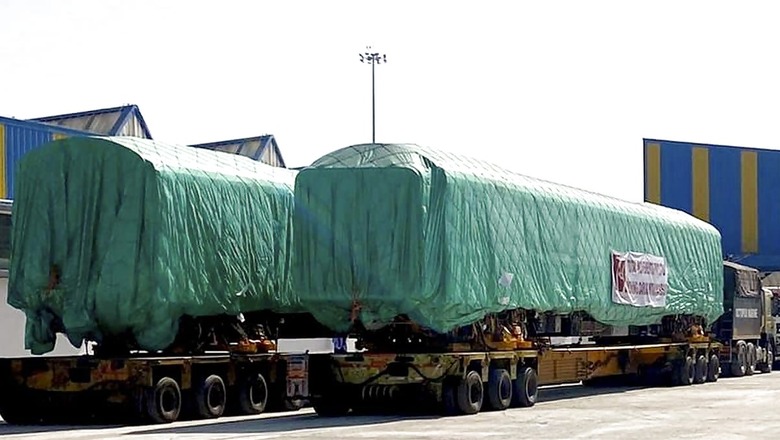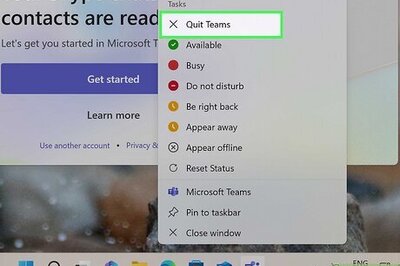
views
From being the first set of trains to use artificial intelligence (AI) to plying on Bengaluru’s first double-decker flyover, Namma Metro’s yellow line service, connecting India’s Silicon City from Bommasandra to R V Road, has many firsts along its route.
Having travelled 8,500 km from the China Railway Rolling Stock Corporation (CRRC), Nanjing, the China-made driverless Metro train set was hit by a series of roadblocks that led to delays in the launch. The Bengaluru Metro Rail Corporation Limited (BMRCL) officials, however, told News18 that it is now back on track and the 19-km line will be officially operational in the next six months.
The use of AI to monitor the health of the trains, tracks, and the signalling system certainly make the line unique. “Maintenance officials check the tracks every night to cover long distances by foot on the line, checking every nut and bolt. With this new train, we have an automatic track-monitoring system, which is AI-based. This will capture the tracks and fittings. If there are any loose bolts, the image will be rendered to the command centre. This way, we can immediately resolve the issue, which, as of now, is manual and cumbersome,” explained a BMRCL official.
He added that on the yellow line, two trains will run on a pilot basis. With trains running regularly, tracks undergo wear and tear. They generate heat called hot axle detection, which could lead to engine seizure. An alarm is sounded to the command centre, and immediate action can be taken to withdraw the train or check the lines. “These trains are based on the Communication-Based Train Control (CBTC) system, which simply means two trains can communicate with each other when on the tracks. This also helps us to go for an unattended train system or driverless trains,” he said.
FROM SHANGHAI TO BENGALURU
Let’s trace how the two prototype train sets travelled from Shanghai to Bengaluru. The coaches left the Nanjing Puzhen factory in China on January 10, and the entire journey from China to Bengaluru’s Hebbagodi spanned across 36 days. The BMRCL fondly called the coaches ‘YellowLove’, as they landed in Bengaluru on February 14, popularly celebrated as Valentine’s Day.
The prototypes were loaded onto a vessel bound for India from the Shanghai port on January 17, and the six cars of the train set arrived in Chennai on February 6. After customs clearances, the specially designed yellow coaches were dispatched from the Chennai port to Bengaluru’s Hebbagodi around midnight on February 14. The coaches saw multiple layovers in Kanchipuram, Vellore and Krishnagiri before they arrived in the IT capital. This was because heavy goods vehicles can only travel overnight, as there are heavy restrictions on transporting them during the day.
Having unloaded the coaches, the train formation was conducted on February 20 and is currently undergoing a series of tests. The BMRCL will require a minimum of three months to conduct trial runs and obtain approvals for commercial operations before it is rolled out and shuttles between 16 metro stations.
“It is now on the inspection bay line. After the completion of manufacturing and factory tests, the train sets will be delivered to the respective BMRCL depots in Bengaluru for further static and dynamic tests. Static tests will be done by February, and then we conduct thorough dynamic tests. Nearly 30-40 tests are conducted, including integrated tests before we begin the service trials conducted on the main lines,” BL Yashwanth Chavan, BMRCL Chief Public Relations Officer, said.
Designwise, the train stands apart with sleeker grab handles and smarter-looking seating and an aesthetically sharper outer body look. “In the new train, we have a stainless-steel body compared to the aluminium body in the older trains. Apart from this, power generation will be more advanced, as the brake system is more advanced,” Chavan further explained.
THE HURDLES
In 2019, before the pandemic hit, a contract worth Rs 1,578-crore was signed between BMRCL and the CRRC and an order to deliver 216 metro coaches to operate on the yellow line of the Bengaluru Metro was placed. However, according to the contract, the coaches were to be made in India as per Prime Minister Narendra Modi’s ‘Make in India’ policy. The delivery of patches did not take place as the Chinese company initially failed to establish a manufacturing plant in India in the mentioned timeframe.
It further faced delays when there were visa-related issues for the Chinese engineers who were to accompany two prototypes.
“The first prototype is the train that undergoes a lot of testing before it is certified technically. There was a very specific clause that other than the prototype, all other trains had to be manufactured in India. There was an attempt to set up a manufacturing unit in India, but that did not happen. The pandemic hit and post-Covid, the coach company failed to get certain required approvals,” Chavan told News18.
Chavan said that a clause in the contract allowed subcontracting the building of the train sets to an Indian company, and this is when Titagarh Rail Systems Limited (TRSL), Kolkata, bagged the contract to build the remaining coaches for BMRCL in phases.
THE DISRUPTIONS
Recently, the Metro faced a series of disruptions of services, including one incident where the train operations were affected for close to four hours. Office-goers landed up on Metro stations, and many remained stranded as the frequency of the trains reduced due to lower speed. This caused a major commotion, and stations like Kempegowda Metro station, a major junction, saw a huge pile-up of Metro travellers.
“The purple line service briefly slowed down as a technical snag developed. This line has been operational for a decade now, and a minor chip malfunction had affected the signalling system. This caused the trains on the line to run at a slow speed. The snag was noticed at 6:14 am, and BMRCL made regular announcements,” Chavan reacted to the incident.
BMRCL clarified that three other incidents that were reported as technical snags or delays on the Metro lines since January were due to unforeseen incidents. “On January 1, a woman’s mobile fell on the tracks along the purple line, and she tried to retrieve it. Our security units rushed in and pulled her out. But it was a concerning issue, so the track was blocked for 20 minutes to resolve it. The second incident on January 5 when a passenger allegedly jumped on the green line metro tracks in an alleged suicide bid forced us to shut down the line for an hour. Both times, we took action to save lives,” the official said.



















Comments
0 comment